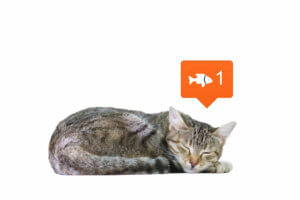Social Networks Change How You Perceive Animals


Written and verified by the biologist Samuel Sanchez
There’s no doubt that we live on a globalized planet and have the ability to be continuously connected. The Internet allows users to share, obtain knowledge, and even make a living. This is supposed to be the information age and yet few people are aware that social networks change the way we perceive animals.
Despite the many benefits of online media, we must take certain things into account when exhibiting our pets on our personal pages and when looking for reliable information about the animal kingdom.
How social networks change how you perceive animals
Social networks are all the rage and this isn’t surprising. Even so, here are some facts to put them into perspective:
- Estimates indicated that 4540 million people have access to the Internet in 2019 (59% of the world’s population)
- Instagram has 1 billion active users today
- The Facebook platform has about 2320 million users worldwide
These are astronomical figures, as you can see. Several studies show how this activity translates into the world of animal care.
For example, 80% of searches related to animal care (animal store, dogs, dog food, for example) considerably increased in the last four years. “Pet store” is the most searched for reference out of all analyzed terms.
Similarly, the presence of animal pages on social networks is also on the rise. Estimates indicate that there are over 100,000 active links to pet portals.
The intention of the data is to try to show the importance of pets in the information age. Not only are they present in adorable photos and videos but their owners are continuously looking for information to improve their quality of life – or so they think.

Animals and social networks – a world of lights and shadows
Social networks can alter our perception of the animal world according to several scientific studies. Of course, it depends on the context and population stratum.
For example, the results were quite different when researchers presented two stories about primates to various participants: one in favor of keeping monkeys in captivity and the other against it. (Note that the image in the articles was the same in both.)
- The participants exposed to the negative news attributed higher levels of stress in the animal in the image.
- The negative news promoted a discussion in the comment box, where there were “echo chambers” in which almost all the members had a similar opinion.
- The news in favor of keeping monkeys as pets caused more distrust among the readers.
- In general, they noted that participants were less vocal about animal welfare on social networks than in non-social media.
Thus, Internet users’ response to the same image depends largely on the context. This can soften or increase the level of awareness and critical thinking about the animal world in a way.
Awareness about how you perceive animals on social media
In addition to these results, there were other studies about the impact of the presence of animals in social networks and educational media on children.
Some people believed the existence of drawings, imitations, and interpretations of diverse living beings was negative for the awareness of infants about nature and ecosystems. The logic behind it is children would have a biased association with nature. However, this isn’t accurate.
For example, these studies revealed that the presence of anthropomorphic animal figures (interpreted from a human point of view) in educational material doesn’t affect the level of children’s understanding of living beings at all.
Those exposed to information about the natural world came out with more knowledge, regardless of the anthropomorphic figures, drawings, and material accompanying the exposed informational content. There’s a possibility for knowledge as long as there’s reliable information.

A matter of nuances
As you can see, the interaction between animals and social networks in human culture is complex, to say the least. For example, children don’t seem to mind the presence of informative material transformed from a completely human point of view.
Similarly, studies suggest that, depending on the source and information, one can attribute different characteristics to the same animal images. Finally, we can modulate the level of the debate depending on the portal.
There’s no doubt that we live on a globalized planet and have the ability to be continuously connected. The Internet allows users to share, obtain knowledge, and even make a living. This is supposed to be the information age and yet few people are aware that social networks change the way we perceive animals.
Despite the many benefits of online media, we must take certain things into account when exhibiting our pets on our personal pages and when looking for reliable information about the animal kingdom.
How social networks change how you perceive animals
Social networks are all the rage and this isn’t surprising. Even so, here are some facts to put them into perspective:
- Estimates indicated that 4540 million people have access to the Internet in 2019 (59% of the world’s population)
- Instagram has 1 billion active users today
- The Facebook platform has about 2320 million users worldwide
These are astronomical figures, as you can see. Several studies show how this activity translates into the world of animal care.
For example, 80% of searches related to animal care (animal store, dogs, dog food, for example) considerably increased in the last four years. “Pet store” is the most searched for reference out of all analyzed terms.
Similarly, the presence of animal pages on social networks is also on the rise. Estimates indicate that there are over 100,000 active links to pet portals.
The intention of the data is to try to show the importance of pets in the information age. Not only are they present in adorable photos and videos but their owners are continuously looking for information to improve their quality of life – or so they think.

Animals and social networks – a world of lights and shadows
Social networks can alter our perception of the animal world according to several scientific studies. Of course, it depends on the context and population stratum.
For example, the results were quite different when researchers presented two stories about primates to various participants: one in favor of keeping monkeys in captivity and the other against it. (Note that the image in the articles was the same in both.)
- The participants exposed to the negative news attributed higher levels of stress in the animal in the image.
- The negative news promoted a discussion in the comment box, where there were “echo chambers” in which almost all the members had a similar opinion.
- The news in favor of keeping monkeys as pets caused more distrust among the readers.
- In general, they noted that participants were less vocal about animal welfare on social networks than in non-social media.
Thus, Internet users’ response to the same image depends largely on the context. This can soften or increase the level of awareness and critical thinking about the animal world in a way.
Awareness about how you perceive animals on social media
In addition to these results, there were other studies about the impact of the presence of animals in social networks and educational media on children.
Some people believed the existence of drawings, imitations, and interpretations of diverse living beings was negative for the awareness of infants about nature and ecosystems. The logic behind it is children would have a biased association with nature. However, this isn’t accurate.
For example, these studies revealed that the presence of anthropomorphic animal figures (interpreted from a human point of view) in educational material doesn’t affect the level of children’s understanding of living beings at all.
Those exposed to information about the natural world came out with more knowledge, regardless of the anthropomorphic figures, drawings, and material accompanying the exposed informational content. There’s a possibility for knowledge as long as there’s reliable information.

A matter of nuances
As you can see, the interaction between animals and social networks in human culture is complex, to say the least. For example, children don’t seem to mind the presence of informative material transformed from a completely human point of view.
Similarly, studies suggest that, depending on the source and information, one can attribute different characteristics to the same animal images. Finally, we can modulate the level of the debate depending on the portal.
All cited sources were thoroughly reviewed by our team to ensure their quality, reliability, currency, and validity. The bibliography of this article was considered reliable and of academic or scientific accuracy.
- Mkono, M., & Holder, A. (2019). The future of animals in tourism recreation: Social media as spaces of collective moral reflexivity. Tourism Management Perspectives, 29, 1-8.
- Geerdts, M. S., Van de Walle, G. A., & LoBue, V. (2016). Learning about real animals from anthropomorphic media. Imagination, Cognition and Personality, 36(1), 5-26.
- Estudio del sector mascotas en internet, liftingroup.com. Recogido 7 de septiembre en https://www.liftingroup.com/pdf/estudio-sector-mascotas-internet-2014.pdf
- ¿What is social media for animals? Socialmediaforanimals.com. Recogido a día 7 de septiembre en https://socialmediaforanimals.com/animal-welfare-news/what-is-social-media-for-animals/
This text is provided for informational purposes only and does not replace consultation with a professional. If in doubt, consult your specialist.








